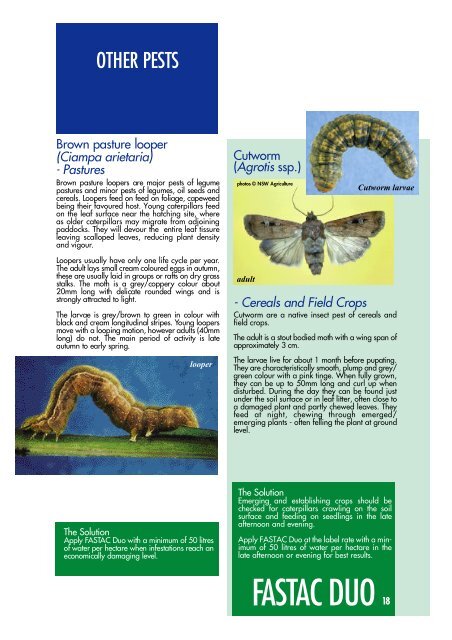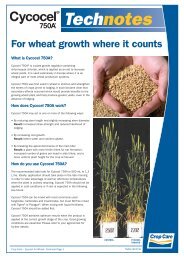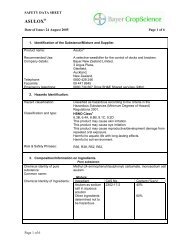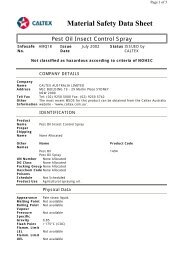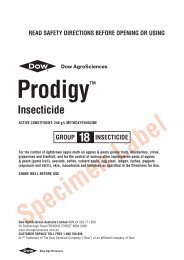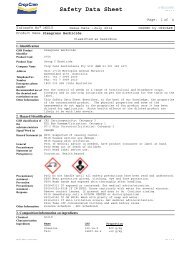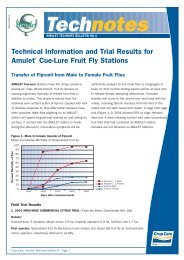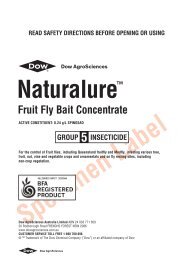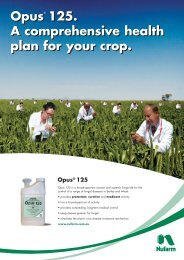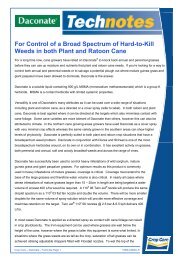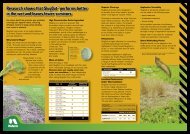Fastac Duo Technical Manual - Pest Genie
Fastac Duo Technical Manual - Pest Genie
Fastac Duo Technical Manual - Pest Genie
You also want an ePaper? Increase the reach of your titles
YUMPU automatically turns print PDFs into web optimized ePapers that Google loves.
OTHER PESTS<br />
Brown pasture looper<br />
(Ciampa arietaria)<br />
- P a s t u r e s<br />
Brown pasture loopers are major pests of legume<br />
pastures and minor pests of legumes, oil seeds and<br />
cereals. Loopers feed on feed on foliage, capeweed<br />
b eing their favoured host. Young caterpillars feed<br />
on the leaf surface near the hatching site, where<br />
as older caterpillars may migrate from adjoining<br />
paddocks. They will devour the entire leaf tissure<br />
leaving scalloped leaves, reducing plant density<br />
and vigour.<br />
C u t w o rm<br />
(Agrotis s s p . )<br />
photos © NSW Agriculture<br />
Cutworm larvae<br />
Loopers usually have only one life cycle per year.<br />
The adult lays small cream coloured eggs in autumn,<br />
these are usually laid in groups or rafts on dry grass<br />
stalks. The moth is a grey/coppery colour about<br />
20mm long with delicate rounded wings and is<br />
strongly attracted to light.<br />
The larvae is grey/brown to green in colour with<br />
black and cream longitudinal stripes. Young loopers<br />
move with a looping motion, however adults (40mm<br />
long) do not. The main period of activity is late<br />
autumn to early spring.<br />
looper<br />
adult<br />
- Cereals and Field Crops<br />
Cutworm are a native insect pest of cereals and<br />
field crops.<br />
The adult is a stout bodied moth with a wing span of<br />
approximately 3 cm.<br />
The larvae live for about 1 month before pupating.<br />
They are characteristically smooth, plump and grey/<br />
green colour with a pink tinge. When fully grown,<br />
they can be up to 50mm long and curl up when<br />
disturbed. During the day they can be found just<br />
under the soil surface or in leaf litter, often close to<br />
a damaged plant and partly chewed leaves. They<br />
feed at night, chewing through emerged/<br />
e m e r ging plants - often felling the plant at ground<br />
level.<br />
The Solution<br />
Apply FA S TAC <strong>Duo</strong> with a minimum of 50 litres<br />
of water per hectare when infestations reach an<br />
economically damaging level.<br />
The Solution<br />
Emerging and establishing crops should be<br />
checked for caterpillars crawling on the soil<br />
surface and feeding on seedlings in the late<br />
afternoon and evening.<br />
Apply FASTAC <strong>Duo</strong> at the label rate with a minimum<br />
of 50 litres of water per hectare in the<br />
late afternoon or evening for best results.<br />
FA S TAC DUO<br />
1 8


